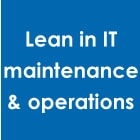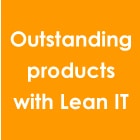


How we used Lean Software Development pr...
On the way to develop their Lectra PLM solution, the teams at Lectra encountered the same problems and obstacles that other software houses do: delays, quality and costs issues, problems in integrating customer feedback. The Lean Software Development project was introduced to tackle these issues. Deploying the new approach was a real challenge due to the scale (70+ people involved) and the number of various technologies involved. Yet we achieved results we never had before: we delivered a complete and comprehensive version of our software solution on time with a quality...
Gemba walks in IT project management:
A domain manager in the IT department of a large Italian bank, is learning to see waste in her IT operations, and realizing that the gemba reality is often different from what she ever imagined. Learning to see in IT is not easy. Knowing which questions to ask, where to look and what to explore deeper is a technique one acquires by practicing over and over. But you can only make better decisions after you’ve been there.
...

Learning from the fast developing practi...
As Lean practice within IT grows and blends with complementary disciplines, including Agile, Scrum, ITIL, COBIT, Six Sigma, BPM, and others, we are learning new ways to solve big problems, and to create and leverage strategic opportunities. Steve Bell reflects on the current state of Lean IT, sharing examples from his practice as a Lean coach, researcher and author to show how enterprises—from global conglomerates to startups—are applying Lean IT principles and practices to drive innovation and operational excellence, and how you can apply these lessons learned and...
Breaking through the legacy of mass prod...
In the summit opening keynote session, Pr Daniel Jones presented: “Breaking through the legacy of mass production: is IT part of the problem or how could it really help to unlock the future?” Escaping the Legacy of Mass Production by Prof Daniel T Jones from Institut Lean France...
